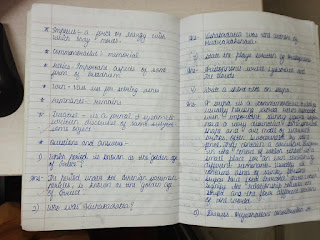Civics - Pastoral Living (Extra Questions)
2. What is NABARD? How does it help the farmers?
9. What is the number of people involved in marine fishing?
1. What is irrigated farming?
Crops are grown during the summer season with the help of irrigation. This type of farming is known as irrigated farming.
2. What is NABARD? How does it help the farmers?
NABARD is the National Bank for Agriculture and Rural Development. It grants monetary aid for agricultural activities
3. What is animal husbandry?
Animal husbandry includes domestication of animals such as cows, buffaloes, goats, sheep, pigs, camels, horses, donkeys and yaks.
4. Why are animals reared?
To obtain animal yields such as milk, meat, wool and skin.
5. How do women play an important role in dairy development?
They care, feed and milk the animals. They work together with men and contribute to family earnings.
6. What steps are taken by the government?
Steps are taken to boost women’s leadership skills, encourage savings and contribute to women’s empowerment. In some states, dairy cooperatives are formed with membership as well as the management entirely composed of women milk producers.
7. Where is fishing carried out?
Fishing is carried on in rivers, lakes, seas, creeks and oceans.
8. How many marine fishing villages do we have in India?
3202
9. What is the number of people involved in marine fishing?
There are 9 lakh people involved in active fishing.
10. List the fishing related occupations.
People are involved with fishing related occupations such as net mending, marketing of fish, peeling, curing, and preservation and processing.
11. What is the number of people involved in fishing related activities?
15 lakh
12. Where is Bastar situated ?
Bastar is situated in the state of Chhattisgarh.
13. How many different tribes can we find in Bastar?
40 different tribes.
14. What is Bastar known for?
It is known for its vibrant tribal markets known as haats.
15. What is Chapura?
Chapura, a chutney made from red ants and chilies, is the peculiar delicacy here. One can see people eating hundreds of live red ants given on a leaf.
16. What is rain-fed farming?
Rabi and Kharif crops are mainly cultivated with the help of rain water. This type of farming is known as rain-fed farming.
17. What is irrigated farming?
Crops are also grown during the summer season with the help of irrigation. This type of farming is known as irrigated farming.

































